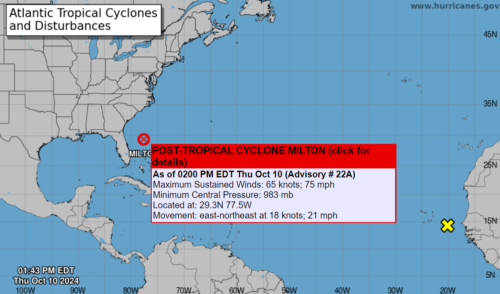by Marco Lopez
BELIZE CITY, Thurs. Oct. 10, 2024
Hurricane Milton made landfall near Sarasota, Florida, around 8:30 p.m. on Wednesday as a category 3 storm. It exited the state off the east coast as a category 1 on Thursday evening. Governor of Florida, Ron DeSantis said an official death toll would be confirmed and shared by Thursday evening, but unconfirmed reports point to at least 12 killed in connection with this storm.
Deadly tornadoes, as many as 38, according to President Joe Biden, ripped through the state as the storm approached on Wednesday evening – killing five people – according to Sheriff Keith Pearson of St. Lucie County.

Sheriff Michael Chitwood of Volusia County confirmed that three fatalities were confirmed in that area, saying that one person died after a tree fell, but that the causes of the deaths of the other two persons are unknown.
In St. Petersburg, the Chief of Police, Anthony Holloway, said this morning that two storm-related deaths were confirmed in that city.

Director of the National Hurricane Centre, Michael Brenan told CNN on Thursday, “The tornadoes we saw develop yesterday in Milton were really kind of supercharged compared to the typical tornadoes you see in a hurricane environment.” He described them as “longer living” and “more powerful.”
DeSantis, in a press conference this morning, described the storm as “significant, but not the worst-case scenario,” pointing out that the impact left behind by Hurricane Helene (September 26) – reported to have killed over 220 people (20 of whom were from Florida) – was more severe.
The height of the storm surge brought by Milton was less than the levels that were forecasted as part of the most dangerous possible scenarios.
Milton is currently a post-tropical cyclone heading along the US east coast – bringing with it tropical storm conditions to those coastal states and over the extreme northwestern portion of the Bahamas.
As of 2:00 p.m. on Thursday the storm was moving east–northeast at 18 knots or 21 mph, with minimum central pressure of 983 millibars and maximum sustained winds of 65 knots or 75 mph.
As of Thursday afternoon, there were about 3.4 million people without power. Power has been restored to about 700,000.
More than 80,000 persons remained in shelters, and hundreds were rescued, according to DeSantis. This number is a far cry from the thousands who had to be saved following the impact of Hurricane Helene, according to the Florida governor.

